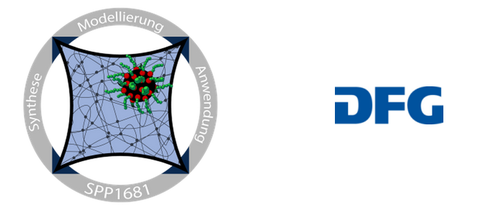DFG - Priority Program 1681
The use of magnetic fields is an external stimulus for the control of material properties, which is of considerable technical interest, since magnetic fields can easily be generated and controlled. Magnetically controlled materials such as suspensions of magnetic nano - and microparticles - ferrofluids and magneto - rheological fluids - have the ability to exhibit strong changes of material behavior at reasonable technical effort. In the aforementioned fluids, the matrix in which the particles are embedded, ie. the carrier liquid, constitutes only a thermal bath which, although changing the typical time constants of the material, does not provide any specific interaction between the particles and the matrix. In contrast, magnetorheological elastomers in which magnetic particles are embedded in an elastic matrix are a first step in the direction of magnetic hybrid materials with controllable particle-matrix interaction.
In such materials formed by a particulate magnetic component in a complex matrix, the mutual influence of particles and matrix provides an additional set of parameters in the material behavior. This can provide the possibility for a magnetically controlled change of material properties. The knowledge of the interaction between the particles and the surrounding matrix is an important element for the understanding of the material behavior itself, and thus the basis for a targeted development of such materials for novel applications in actuators and sensors.
Recently, significant progress has been made in terms of both synthesis and modeling and feature analysis of magnetic hybrid materials, making the objectives of this program in the first place accessible. The program thus spans the field of problems from the synthesis of magnetic hybrid materials over the characterization of material behavior and microstructure and their theoretical description towards technical and medical applications. The result is a highly interdisciplinary field of research that extends from chemistry to materials science, experimental and theoretical physics and towards engineering sciences and medicine.
In the center the priority program focuses on five key issues: First, it must be clarified, how (1) the material behavior of a magnetically controllable hybrid material is influenced by the particle-matrix interaction and how appropriate materials can be synthesized. A multi-scale modelling of the material properties (2) is the fundament for the understanding of the behavior of the materials necessary to explain their magnetic controllability at a microscopic level. The odelling is also needed for the establishment of constitutive material laws, which are needed for the design of applications. Closely connected to this modeling of the material properties is (3) the experimental evaluation of the material properties and its connection to changes in the microstructure. Based on this understanding of the magnetic hybrid materials one can answer the question (4) what kind of possibilities they offer in novel actoric and sensory applications, as well as the question (5) how the effectiveness of the biomedical use of magnetic nanoparticles can be improved by a control of the interaction between the functionalized particles and tissue.

